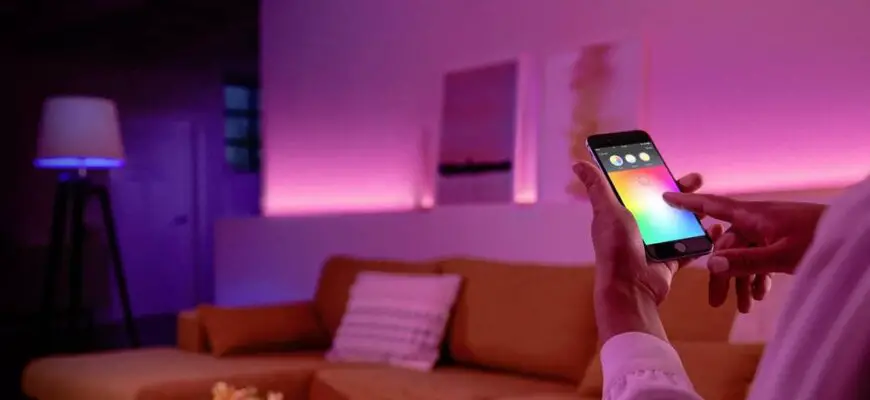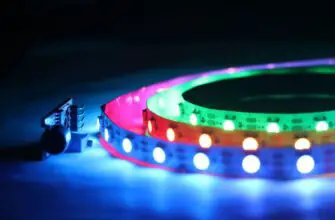Today LED light strips have become part of our everyday life.
We use them outdoors and indoors, as a decoration element, as basic lighting or as supplementary lighting, in offices and dwelling premises.
Sets of the LED strip lights can be supplied both with remote control devices or without them.
In our article, we’ll consider the LED light strip remote control instructions in detail.
However, to avoid the occurrence of any misunderstanding, let’s straighten out the definition and basic peculiarities of remotes used for a light-emitting diode.
Definition of an LED strip light controller

A strip light remote is a portable device intended for wireless control using radio frequencies captured by a receiver linked to an LED strip.
The LED light strip remote has the form of a plastic box with buttons intended to activate functions, such as switching on and off, adjusting brightness, changing a color, and voice control.
The relevant receiver captures and controls the signals remotely.
The features of the remote control of LED light strips
In general, the LED light strips of different models are completed with the remote controllers having different parameters of technical characteristics, such as a power supply voltage, a principle of communication with other devices, a sensing distance, an emitting power, and the size of a controller.
When choosing a ‘right’ remote control the following features should be kept in mind to ensure the perfect control of LED strips.
Power supply voltage

The LED strip lights are commonly on batteries, the voltage of which depends on the voltage of your light strip. Usually, strip light devices work 12V or 24V.
As a rule, manufacturers supply the strip light devices with dedicated batteries which totally. Preferably, these are rechargeable lithium batteries.
Range of a sensing distance
It is recommended to use the controllers with a sensing distance of not less than 60-100 feet to provide flexible control. This will allow to you control your LED strip lights from any place in a room.
Principle of communication with other devices
A controller communicates with a strip light device via radio channels by capturing the signals emitted from light strips.
The size of a remote controller
Having a compact strip light controller (and, accordingly, a receiver) of smaller size is preferable to provide its portability. It will allow you to place and carry it comfortably in any place, even in a pocket.
In addition to the above, modern smart controllers have such features as time control, mode selection, and application control.
Algorithm of setup and operation of a remote controller
The steps required to set up and operate a remote should be performed in the sequence shown below.
The first step is mounting an RF receiver. Usually, the accessories for mounting, such as a suitable bracket or an adhesive are included in a supply.
Secondly, the receiver should be connected to a strip.
Then power a strip and synchronize a remote and a receiver using the relevant buttons.
The buttons and functions they activate

While the remote control devices differ in some parameters, the principles of operation of one remote device don’t differ from other ones. They all are provided with buttons of a corresponding color specifically intended for a particular function. Pressing on a button results in switching to a desired function.
For switching on and off, the button usually located in the upper right corner is used while in some remotes the on/off button is located in the center. As a rule, the ‘On/Off‘ buttons are red.
A ‘Pause/Switch‘ button commonly is black and contains a triangular arrow on it. This button is usually located in the upper right corner.
For changing a light color in a static mode, 20 buttons of different colors are used. In some models, rotating knobs or touchpad can be used instead of buttons.
To adjust brightness, the buttons with the sun thumbnails and arrows directed up or down are used.
Using a ‘DIY‘ button you can switch between DIY modes. This means that you can create your own modes. A long press on a DIY button will allow you to set the desired colors.
To select a jump mode, you can switch the relevant buttons. A figure symbol attached to the ‘JUMP‘ mode sign determines the number of colors to select.
An ‘AUTO‘ button is used to activate the automatic switching. The automatic switching covers all modes. Usually, a jump mode and a static mode are available.
‘Quick‘ and ‘Slow‘ buttons are intended to regulate the speed of color change.
Measures of precaution
Replace used batteries on time.
Do not allow long-term storage of the remote control with exhausted batteries.
Do not leave the remote control near heating devices or hot surfaces.
Do not allow water or condensation to enter the device.
Do not expose the remote control to falls from a height, hard impacts, vibration, and other mechanical influences
In case of serious damage, consult an after-sales service.
Final words

In our article, we’ve attempted to present the basic instructions on how to use the remote control.
In conclusion, we’d like to add that the remote wireless control takes the LED lighting to a higher level of functionality.
Frequently Asked Questions
Why doesn’t my LED light remote work?
Remote controllers of your LED lights may fail to work for different reasons. The most often faced reasons are as follows:
The protective strip between the batteries has not been removed or the battery has not been inserted. The battery is low. The controller is located outside the signal propagation area of the remote control. The remote control is not linked to the controller.
In addition, the failure may be caused by a low charge of the battery.
In some cases, the battery replacement or long press on the particular reset buttons can be an adequate troubleshooting measure. However, in more serious cases, it is recommended to consult an after-sales service.
How do you put LED strips in pairing mode?
Pairing mode is a function that allows you to link your device, for example, a smartphone, with other devices via Bluetooth or Wi-Fi.
If you have a smart LED strip light, it can be easily connected to your smartphone.
To put a smart LED strip light in pairing mode, it is required to install a dedicated application on a mobile device. This will allow you to control the lighting level, brightness and color change, and other features, including voice control.
How do I adjust the speed of color-changing effects on the LED light strip?
If your LED light strip features color-changing effects, use the “Speed” buttons on the remote control to adjust the speed. Press the “+” button to increase the speed and the “-” button to decrease it.
What should I do if the LED light strip doesn’t respond to the remote control?
If the LED light strip doesn’t respond to the remote control, try the following troubleshooting steps:
1. Ensure that the remote control has fresh batteries and is pointed towards the infrared receiver on the LED controller.
2. Check if there are any obstructions between the remote control and the LED controller.
3. Reset the LED controller by unplugging it from the power source and plugging it back in after a few seconds.
4. If the issue persists, refer to the user manual for further troubleshooting or contact customer support for assistance.
Can I control multiple LED light strips with a single remote control?
Depending on the LED light strip model and remote control, some remotes may be able to control multiple LED light strips if they are connected to the same controller or if they operate on the same frequency. Consult the user manual for compatibility and instructions on how to sync multiple LED light strips with a single remote control.










